Community Input: Strategies, Impact, and Best Practices
Updated On: October 26, 2025 by Aaron Connolly
Understanding Community Input
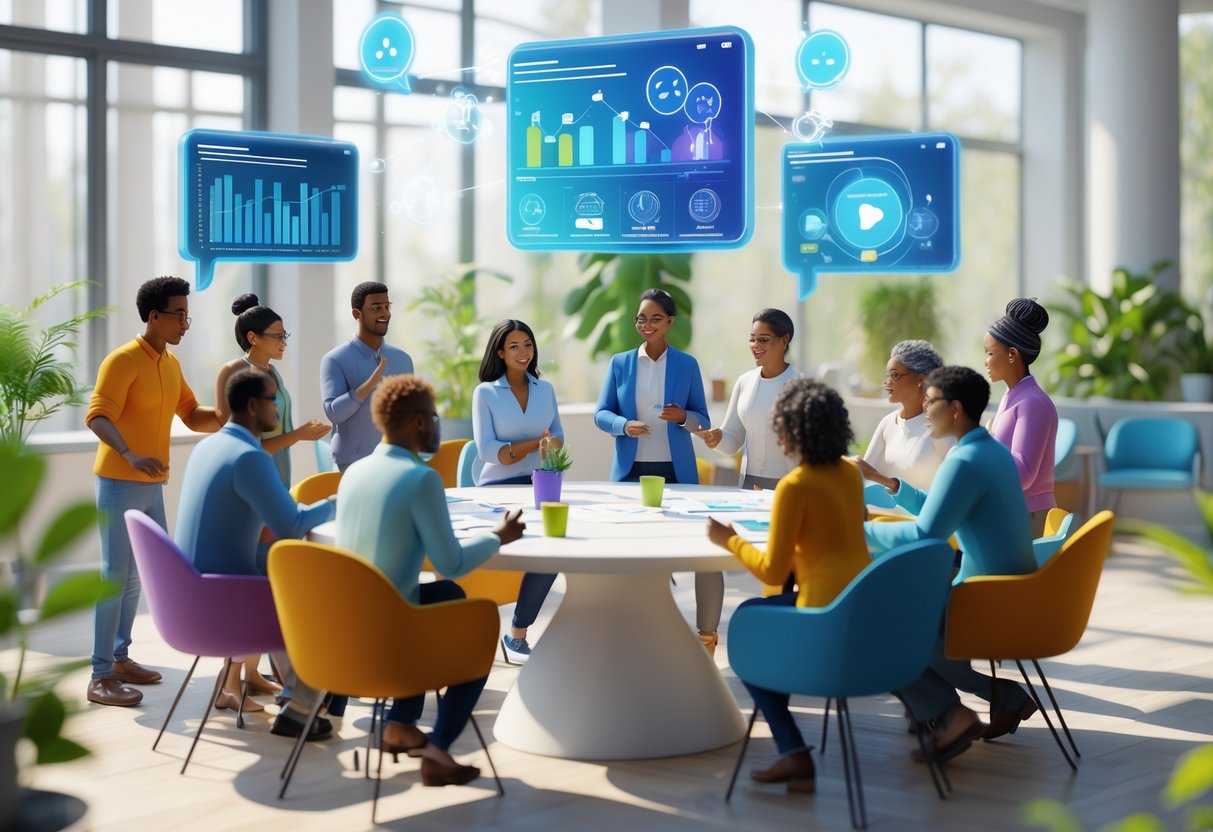
Community input is all about the voices, opinions, and feedback that people share about choices that touch their lives. Over time, it’s grown from simple public meetings into much more creative engagement strategies, putting real effort into reaching more people and having actual conversations.
Definition and Objectives
When we talk about community input, we’re really talking about gathering thoughts, opinions, and ideas from folks who live in or are affected by decisions in a place. It’s not just about filling out surveys or dropping a note in a box.
The big idea? Make sure people actually get a say in what happens around them. Whether it’s new housing or changes in local services, their input counts.
Key objectives include:
- Inclusive participation – reaching people who might otherwise stay silent
- Better decision-making – tapping into local knowledge for smarter choices
- Building trust – showing leaders really listen
- Identifying real needs – understanding what people genuinely want
Community input works best when equity comes first. We need to hear from folks of all backgrounds, ages, and circumstances—not just the loudest ones.
Historical Context and Evolution
Community input has changed a lot in recent decades. In the past, people relied on formal public meetings and written comments.
Old-school methods included:
- Town hall meetings
- Planning committee hearings
- Letters to councils
- Basic surveys
But these methods left out a lot of folks. Busy parents missed evening meetings. Anyone without a car or good transport found it tough to get there. And if English wasn’t your first language, you might not have been heard at all.
Now, we use all sorts of channels to reach people. Online platforms, mobile outreach, and engagement that fits different cultures have become the norm.
Today’s approaches include:
- Digital surveys and apps
- Pop-up consultation stands
- Community ambassadors
- Social media engagement
- Multilingual materials
The shift is clear: if we want real input, we have to meet people where they are—not wait for them to come to us.
Key Stakeholders
Many groups have a stake in community input. Each brings something different to the table.
Primary stakeholders:
| Stakeholder | Role | Key Interest |
|---|---|---|
| Residents | Share lived experience | Daily life impacts |
| Local organisations | Speak for specific groups | Community needs |
| Businesses | Offer economic perspective | Commercial viability |
| Council officers | Carry out decisions | Practical feasibility |
| Elected representatives | Make final calls | Public accountability |
Community members sit at the heart of any input process. They know how things really work and what changes would mean for their lives.
Advocacy groups often step up for people who can’t participate directly, like disability groups, cultural associations, or tenant unions.
Professional stakeholders—planners, social workers, health pros—bring technical know-how. They help turn community ideas into workable plans.
The best input processes give space for all these voices. When expertise and lived experience meet, good things usually follow.
Principles of Effective Public Engagement
If you want public engagement to work, you need to make participation open to everyone, build trust with honest communication, and show people their input matters. These basics help agencies move past checking boxes and actually collaborate.
Inclusivity and Accessibility
We should design engagement so all kinds of voices feel welcome and remove barriers. That means more than just town halls or online forms.
Remove Physical Barriers
Choose venues that anyone can access, offer sign language interpreters, and hold meetings at different times. If possible, provide childcare.
Address Language Barriers
- Translate documents into the main community languages.
- Bring interpreters to public events.
- Use clear, simple language—ditch the jargon.
- Try visual materials for trickier topics.
Meet People Where They Are
Set up pop-up booths at events, libraries, or even shopping centres. Mix in text messages and social media with your usual methods.
Virtual options really opened things up during the pandemic. Now, hybrid meetings (some in-person, some online) are pretty common.
Consider Economic Factors
Keep participation free. If folks need to travel, think about transport vouchers or holding events in more than one spot.
Transparency and Trust
We build trust by being up-front about how things work, what the limits are, and how input will be used. Trust doesn’t come overnight—it takes steady, honest engagement.
Share Information Openly
Let people see project timelines, budgets, and how decisions will be made before you ask for their thoughts. Be clear about what can change and what can’t.
Be Honest About Limitations
If some choices are already set or the budget is tight, say so from the start. It’s better to be upfront than to disappoint people later.
Use Plain Language
Swap out technical terms for everyday words. If you have to use acronyms or industry lingo, explain them.
Document Everything
Keep track of who showed up, what they said, and how their feedback shaped decisions. This shows people their voices matter.
Feedback Loops
We need to show communities how their input made a difference. Closing the loop turns consultation into real collaboration and makes people more likely to join in next time.
Report Back Quickly
Share what you learned within weeks—not months. Keep everyone in the loop, even if you haven’t made a final decision yet.
Show Clear Connections
Use simple charts or summaries to link suggestions to actual changes. If you can’t use an idea, explain why.
Make It Personal
Send thank-you notes. With permission, include quotes from community members in reports. Shout out to community champions who help spread the word.
Track Long-Term Impact
Check in months later to show how input is still shaping things. This builds trust and keeps people engaged.
Use Multiple Channels
Get the word out through newsletters, social media, local papers, and community websites. People like getting updates in different ways.
Methods for Gathering Community Input
You can collect community input with old-school surveys, face-to-face meetings, or more creative, hands-on activities. The best method depends on who you want to reach and what you want to learn.
Surveys and Polling
Surveys are still a go-to for community feedback, especially when you need lots of responses or data on a specific topic.
Online surveys are great for reaching folks who can’t make it to meetings. Tools like Google Forms or SurveyMonkey make it easy to build short, clear questionnaires.
Phone polling works well in places where not everyone is online. Text message polls are catching on, too. People just text their answers to a number.
Paper surveys still matter, especially in some communities. You can hand them out at shops, libraries, or community centres to reach those who aren’t big on tech.
Workshops and Public Meetings
Face-to-face meetings let people dig deeper than surveys alone. They help community members talk things through and bounce ideas off each other.
Town halls are good for big announcements or hot topics. You present, then take questions. It’s direct and you get feedback right away.
Focus groups bring together small groups (usually 8-12 people) to talk about specific issues. A good facilitator helps keep the conversation on track and brings out new insights.
Walking meetings take the discussion out into the community. You can visit real sites, see issues firsthand, and brainstorm solutions on the spot.
Creative Approaches
Sometimes, creative methods pull in people who’d never show up for a meeting or fill out a survey. They can make engagement a bit more fun and open.
Story booths at events let residents share personal stories. Golden, Colorado used this at a block party and heard from over 1,000 people about their town’s future.
Photo contests give residents a way to show both the good and bad sides of their neighbourhoods. Pictures can say a lot.
Interactive displays—like voting with candy in jars—help people show their priorities visually. This works well at festivals or markets.
Youth activities like mural painting let kids show what they love about their community. Sometimes, their ideas surprise the adults.
Innovative Techniques for Community Involvement
Modern engagement calls for fresh ideas. Digital platforms connect residents instantly, pop-up demos let people test ideas in real life, and interactive mapping makes it easier to see changes.
Digital and Online Tools
Digital tools have totally changed the way we get community input. Online surveys and polls reach more people than any town hall ever could.
Crowdsourcing platforms like INPUTiD™ let residents submit and vote on ideas directly. These work especially well for things like budgets or neighbourhood projects.
Social media groups keep conversations going between meetings. Facebook and WhatsApp groups help keep everyone in the loop.
Mobile apps make it easy for people to chime in anytime—whether they’re at home or on the bus.
Virtual reality presentations let people “walk through” new developments before anything is built.
The big win here is accessibility. Digital tools break down barriers like work schedules, child care, or mobility issues that keep people from meetings.
But, let’s be honest, the digital divide is real. Not everyone has the internet or a smartphone. The best programs mix online tools with offline options.
Temporary Demonstrations
Pop-up installations let people try out changes before they become permanent. These hands-on methods get more honest feedback than a drawing or slideshow.
Temporary street closures show what a pedestrian zone could feel like. In Melbourne, “Open Streets” closes roads on weekends so people can walk, cycle, and hang out without cars.
Mock-up installations use things like cardboard bus stops or painted bike lanes to help people picture changes.
Trial programmes run for a while—maybe a few weeks or months—so people can see what works and what doesn’t.
People notice the difference right away. They see how traffic, noise, or social life changes. Sometimes, folks who were against an idea end up supporting it after trying it.
These demos also reveal problems early. Issues like bad sight lines or drainage show up during a trial, not after you’ve spent real money.
Interactive Mapping
Digital maps have made it way easier to see and share ideas. Residents can point out exactly where things need fixing or improving.
Online mapping platforms let people drop pins to highlight issues or suggest changes. Click on a street, report a pothole, or propose a new playground.
Augmented reality apps overlay plans on real places. Hold up your phone and see how a new roundabout would look.
Heat maps show where the most feedback comes in. Planners can spot the most popular ideas or problem spots at a glance.
Collaborative editing lets groups build a shared vision. Residents can add layers for cycling routes, green spaces, or places they want protected.
These tools make engagement more focused and practical. Instead of vague feedback like “fix the high street,” planners get specific, location-based suggestions.
The visual side helps people understand complicated plans and see how their ideas fit the bigger picture.
Community Input in Planning Processes
Community input shapes how we plan cities, build projects, and make decisions that touch people’s everyday lives. Getting feedback early and using the right methods usually leads to better outcomes for everyone.
Urban and Strategic Planning
Community input really shapes urban development and strategic planning in cities everywhere. When planners bring local voices to the table, projects tend to work better and people are more likely to support them.
Community engagement works because residents genuinely know their neighborhoods inside out. They spot which streets always flood after a storm. They notice where buses never seem to show up. They live with the daily hassles that planners might never see from behind a desk.
Strategic planning has shifted away from those old top-down methods. Now, planners rely on surveys, focus groups, and public meetings to hear what people want. These sessions help uncover community strengths and get at the real issues.
The benefits of community involvement include:
- Tapping into lived experience and local knowledge
- Solving problems with diverse perspectives
- Building stronger support for projects
- Avoiding expensive changes down the line
A lot of planning departments now insist on community consultation before making big decisions. This builds trust. It also sparks new ideas—ones officials might never think up on their own.
Early Stage Engagement
Getting people involved early just makes sense. It saves time, cuts costs, and leads to better results. We always suggest starting engagement before the blueprints are set—not after.
Early engagement lets planners figure out what the community actually cares about. It sidesteps costly redesigns and cuts down on resistance later. Planners can spot potential trouble before it blows up.
Smart planners mix up their outreach. Online surveys catch busy folks. Evening meetings fit family schedules. Weekend events draw in seniors and students. This mix means more people get a say.
SWOT analysis—Strengths, Weaknesses, Opportunities, Threats—works well for early input. Residents can point out what’s working and what’s not. Sometimes, they spot opportunities planners totally miss.
Participation should feel easy and actually matter. People need to see their feedback making a difference. Regular updates and feedback sessions show that their voices really count.
Case Studies in Planning
Real-world stories prove how community input can change planning outcomes. During the pandemic, the Los Angeles County Department of Public Health set up a COVID-19 Equity Community Advisory Council. This group pulled together local leaders and health officials to tackle urgent problems.
The council made a real difference because it trusted community expertise. Local groups knew which neighborhoods struggled most with healthcare. They understood cultural worries about vaccines. They even came up with communication ideas that officials hadn’t considered.
Construction projects benefit too when developers talk to residents early. They find out about traffic headaches, noise problems, or environmental worries.
Planning departments are using digital tools more often now. Online platforms let people comment on proposals and suggest their own ideas. This helps those who can’t show up for evening meetings.
Successful community engagement needs:
- Different ways for people to join in
- Clear info about what’s changing
- Updates showing how input shapes outcomes
- Ongoing relationships, not just one-off chats
Communities that stay involved help improve projects over time. This kind of partnership just leads to better results for everyone.
Role of Community Input in Land Use and Zoning
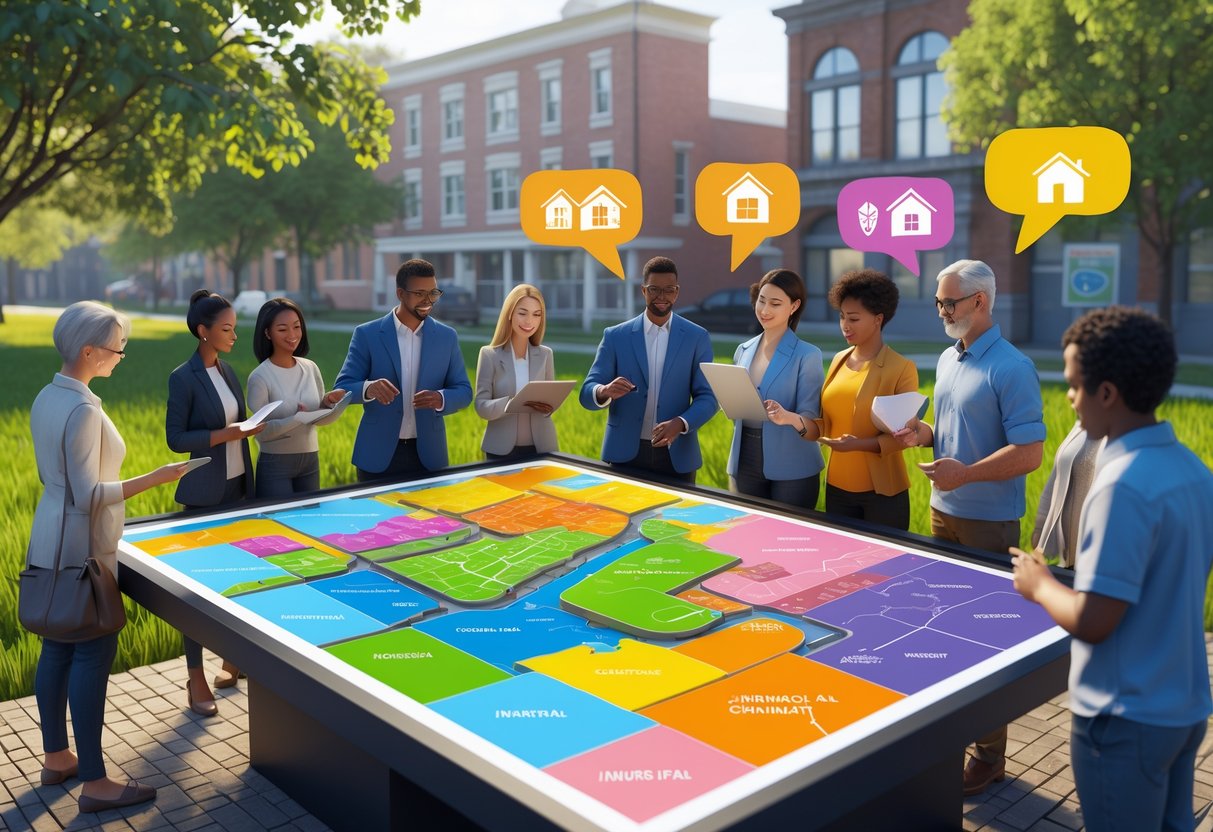
Community voices really shape how we use land and decide what gets built where. Local residents give feedback on zoning changes and guide planning decisions that affect their daily routines.
Zoning Changes and Community Perspectives
Councils rely on community input when considering zoning changes. These decisions can turn a quiet neighborhood into a busy commercial strip.
Residents understand their streets best. They notice traffic flow, noise, and how new buildings might change things.
Key ways communities influence zoning:
- Public hearings for sharing concerns
- Written comments during reviews
- Community meetings with planners
- Surveys about proposed changes
Transparency matters here. Planning departments need to share zoning proposals early so people get a real chance to weigh in.
Many councils now use online tools for feedback. This helps working parents and busy residents take part.
Common concerns include:
- Traffic impact from new buildings
- Property values in the area
- Public services like schools and clinics
- Environmental effects on parks and green spaces
Participatory Land Use Decisions
Planning gets better when communities do more than just comment. Real participation starts early, before the plans are even drawn.
Ways to make participation meaningful:
- Walking tours of proposed sites
- Design workshops with locals
- Focus groups for different demographics
- Online mapping tools for feedback
Planners need to listen and show how community ideas shape final decisions. When residents see their suggestions in the finished plans, trust grows.
Some councils set up citizen advisory committees. These groups meet regularly and give ongoing feedback on planning applications.
Benefits of strong community participation:
- Plans match local needs better
- Less opposition to new projects
- Stronger support for putting plans into action
- More sustainable long-term development
The best decisions balance what the community wants with what’s technically required. That way, developments work for both locals and the wider region.
Addressing Barriers to Participation
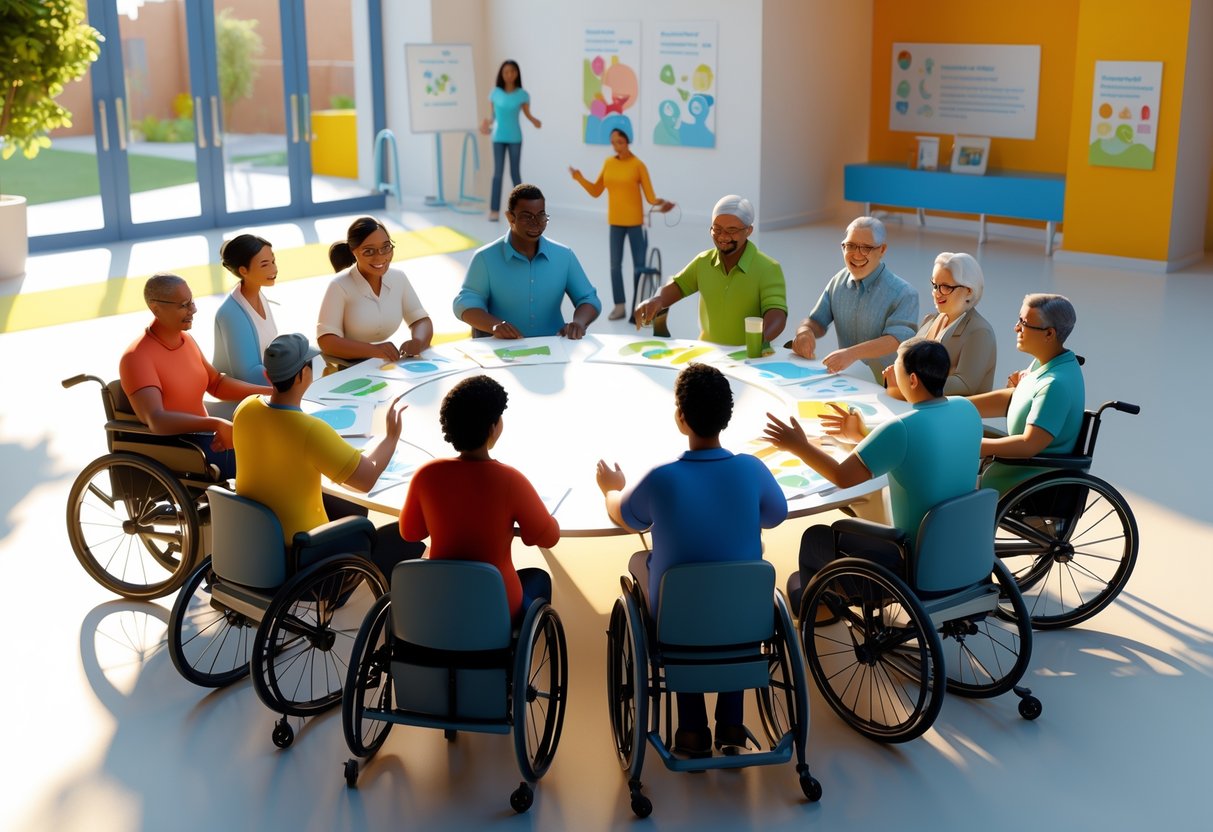
Getting real community input means reaching beyond the usual suspects. We need to make sure everyone has a fair shot at participating. Too often, the same people show up while others are left out.
Reaching Underrepresented Groups
Traditional outreach misses entire groups. We’ve got to be more intentional about connecting with people who face barriers to participation.
Language and accessibility are big hurdles. English-only materials leave out those who speak other languages. Jargon can shut out folks without a formal education.
People with disabilities run into physical and communication barriers. Standard meetings might not work for wheelchair users or those with sensory needs.
Time and location also matter. Working parents or shift workers can’t always make evening meetings. Holding sessions only in wealthy neighborhoods leaves others out.
Some practical fixes:
- Multilingual materials and interpreters
- Meetings at different times and places
- Childcare on-site
- Accessible venues and formats
- Online options
- Creative methods—art workshops, for example
We can’t just wait for underrepresented groups to show up. It’s better to partner with community groups, faith leaders, and disability networks that already have trust.
Mitigating Self-Selection Biases
The same voices often dominate consultations, and that skews the results.
Self-selection issues include loud minorities drowning out quieter folks. Wealthier, more educated residents take part more, while working-class families often sit out. Organised groups show up in force, but average people stay home.
Random sampling can help. Citizens’ juries pick participants by lottery, so discussions are more balanced.
Targeted recruitment works too. We can invite young parents, immigrants, or seniors directly to make sure they’re heard.
Mixing up engagement channels—surveys, focus groups, online platforms, even street interviews—brings in different perspectives. Each approach attracts a different slice of the community.
Sometimes, weighting responses helps balance things out, but this takes careful tracking of who’s participating compared to the community as a whole.
Ensuring Equity in Community Input
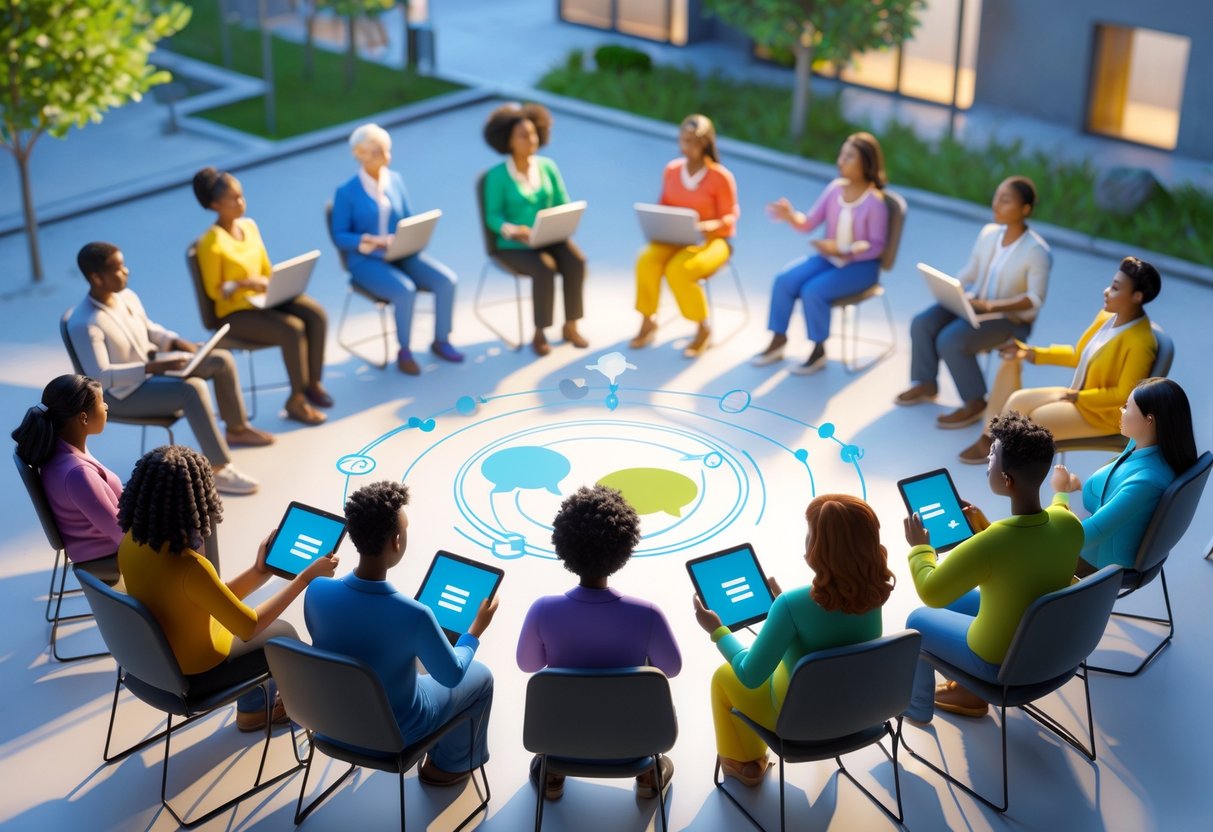
If we want community input to be fair, we’ve got to reach everyone affected by decisions. That means using good sampling, prioritizing those most impacted, and giving people the info they need to contribute.
Statistically Valid Representation
We need feedback that actually matches our community. Start by looking at census data and figuring out who lives here before asking for input.
Start with baseline data. Use census info to map out age, income, languages, and disability rates. That’s your target for who should be represented.
Keep things simple:
- Track participant demographics as you go
- Compare weekly numbers to census data
- Adjust outreach if some groups are missing
Plan for real barriers. Some people need childcare, others need accessible venues or materials.
Budget for:
- Sign language interpreters
- Large print handouts
- Help with transport
- Evening or weekend sessions
Check participation rates by group every week. If certain voices are missing, change your approach right away.
Focusing on Impacted Demographics
We should focus on input from those who’ll feel changes most. A new bus route matters more to daily commuters than to occasional riders.
Map out who’s impacted. Before collecting input, figure out which groups are affected most. Renters and homeowners see new housing policies differently. Road changes affect wheelchair users in different ways than drivers.
Put more effort into reaching these groups:
- Spend most outreach time on high-impact groups
- Use communication channels they actually use
- Meet people where they already gather
Partner up with trusted groups. Disability advocates, neighborhood associations—they already know what matters to their communities.
Work through these networks rather than starting from scratch. It’s faster and more effective.
People with disabilities face unique barriers. Regular meetings might not be accessible. Online surveys might not work with screen readers. We need to offer more than one way to participate.
Providing Factual Context
People can’t give good feedback if they don’t know what’s being proposed. We have to explain things clearly, but not drown folks in technical jargon.
Stick to plain language summaries. One-page overviews with the basics—what’s changing, who’s affected, and when.
Lay out info simply:
- What’s being decided
- Why change is needed
- What options are on the table
- How the decision will be made
Show examples. Policies are abstract, but real-life scenarios make sense. Instead of “revised parking regulations,” say “switching from free 2-hour parking to £1 an hour, first 30 minutes free.”
Tackle common myths up front. Misinformation spreads fast, so address it before it takes hold.
Offer info in different formats. Some want details, others prefer visuals or audio. Community input improves when everyone can access information their way.
Community Input for Public Infrastructure
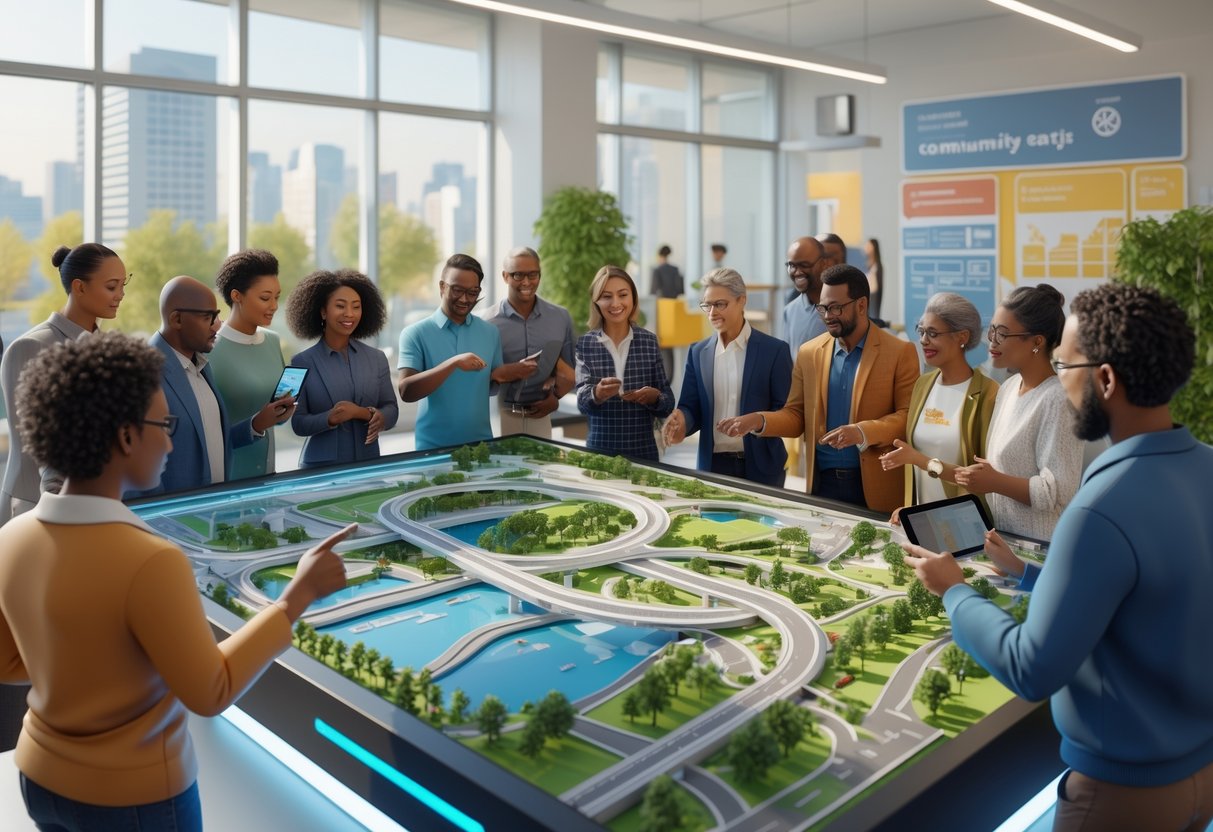
When we build public infrastructure, local feedback leads to better sidewalks, transport, and accessible spaces. Community voices help make sure projects solve real problems—not just what planners imagine.
Sidewalks and Accessible Design
Community input really matters when designing sidewalks and accessible spaces. People with disabilities often spot issues that planners overlook.
Locals know where sidewalk gaps cause headaches. They call out dangerous crossings and places where wheelchairs get stuck.
Community workshops bring out specific needs. Parents with strollers, seniors with walkers, wheelchair users—each group has its own take on the same streets.
Key feedback areas:
- Sidewalk width for mobility aids
- Surfaces that work in all weather
- Where to put dropped kerbs
- Lighting for safety
Some councils now do walking audits with disabled residents. These reveal problems no engineering survey would ever catch.
Transport and Mobility Projects
Transport projects get a huge boost from community input. Residents understand traffic, safety, and what actually works better than any spreadsheet.
Bus planning works when we ask riders about timing and stops. They know where coverage is weak and which routes are empty.
Cyclists spot dangerous junctions and suggest where bike parking is needed.
Good engagement methods:
- Mapping journeys with regular users
- Observation walks at busy times
- Digital surveys for route feedback
- Focus groups with different transport users
Community voices help planners set priorities. Residents might push for safer crossings over fancy landscaping—leading to projects that actually make a difference.
Evaluating and Integrating Input into Decision-Making

Getting community feedback? Well, that’s just the beginning. The real challenge kicks in when we try to turn all that input into decisions that actually help everyone.
Analysing Feedback
We need a straightforward way to look at everything people tell us. Start by tossing feedback into buckets—concerns, suggestions, support, that sort of thing.
Check for patterns. If a bunch of folks mention the same problem, you probably shouldn’t ignore it.
Try using a simple scoring system:
- High impact: Affects a lot of people
- Medium impact: Matters, but to fewer folks
- Low impact: Nice, but not crucial
Keep track of where each comment comes from. Online surveys attract different people than in-person meetings. This way, we spot who we’re missing.
Quick tip: Spreadsheets work fine for logging comments. Just jot down the source, the main idea, and how much it matters.
Balancing Diverse Viewpoints
Different groups want different things, and that’s just how it goes. We have to find ways that work for most people, but we can’t ignore those who aren’t in the majority.
Lay out who wins and who loses with each option. Sometimes, the loudest voices don’t actually speak for everyone.
Think about:
- How many people does this touch?
- Are we hearing from everyone who should have a say?
- What could happen in the long run? (Here’s more on that.)
- Does this fit with our bigger plans?
Just a heads-up: The most popular choice isn’t always the right one. Make sure it’s fair and doable.
Try to find compromises. Maybe residents want more green space, but businesses need parking. Shared-use areas could be a solution.
Communicating Outcomes
People want to know their feedback mattered. If we show them how their input shaped our decisions, they’re more likely to stay involved.
Tell folks what we heard and what we’re planning to do. Be clear about which ideas we’re using and why.
When we can’t use certain suggestions, let’s explain why:
- Not enough money
- Legal stuff in the way
- Tech isn’t there yet
- Needs of different groups clash
Use all sorts of ways to share updates:
| Method | Best For | Timeline |
|---|---|---|
| Newsletters | Detailed updates | Monthly |
| Social media | Quick announcements | Weekly |
| Community meetings | Discussion and questions | Quarterly |
| Project websites | Ongoing progress | Real-time |
Thank people by name if it makes sense. It shows we appreciate their effort.
Keep the updates coming as things move forward. Progress reports help people see their input making a real difference.
Challenges and Critiques of the Community Input Process

Community input isn’t always perfect. Sometimes, it ends up making decisions worse, not better. The process tends to favor wealthier folks and leaves out those who need services most.
NIMBYism and Privilege
Traditional community input puts up huge barriers for working families and marginalized groups. Public hearings can drag on for six hours or more, sometimes into the early morning.
Who Gets Heard vs Who Gets Silenced:
- Overrepresented: White, male, older homeowners
- Underrepresented: Working parents, disabled folks, renters, people of color
You can see it in the numbers. Research from nearly 100 Massachusetts towns found that 63% of comments at housing meetings were negative. Most speakers owned homes and had the free time to stay for hours.
This leads to what people call the “opposition effect.” Folks who are upset or scared find time to speak up. People who support projects or just don’t care much? They rarely stick around for hours to say so.
The Self-Selection Problem
Neighborhood councils sound great on paper, but in reality, they often leave out big chunks of the community. Members need time to campaign, attend meetings, and deal with complicated appointment rules.
What happens? Privileged residents get to speak for neighborhoods they don’t fully represent. When these groups fight against affordable housing or fair school funding, they end up keeping segregation in place—just under the label of “community voice.”
Unintended Consequences
If we don’t give people enough context, community input leads to decisions built on half-baked information. We ask what people think, but don’t always give them the facts they need.
When “Democracy” Blocks Progress
Housing projects get scrapped because a few loud opponents take over hearings. School funding reforms stall when privileged parents organize against change. Infrastructure upgrades get stuck because people fear anything new.
These things happen even when most people might actually support the proposals. The system confuses the loudest voices with what everyone wants.
Missing the People Who Matter Most
Decisions about affordable housing often leave out those who need it. Conversations about public transport happen without riders at the table.
Quick Win: Go out and seek feedback from the people most affected. Don’t just wait for volunteers.
Communities hit hardest usually have the least time and fewest resources to participate. That means policies often end up serving privilege, not real needs.
Future Trends in Community Engagement

Community engagement is on the move. New tech and changing expectations are shaking things up. AI tools are making management easier, and people expect more personal, meaningful interactions than ever.
Emerging Technologies
Artificial intelligence is changing how we run communities. AI can moderate content, highlight important conversations, and show each member what interests them most.
Modern AI can:
- Catch inappropriate posts right away
- Personalize content feeds for everyone
- Spot trending topics before they blow up
- Match members with similar interests
New community platforms are taking over from old-school social media groups. Tools like Circle, Mighty Networks, and iTribe.io offer analytics, event hosting, and more—all in one spot.
These platforms give us more control. We can see how people engage, run events online and offline, and build small groups inside bigger communities.
Gaming expert James Connolly says, “The best community platforms now feel like products themselves, not just add-ons to existing services.”
Quick win: Give a few community platforms a try. See how they stack up against Facebook groups or Discord.
Evolving Social Expectations
People crave smaller, tighter communities now—places where they really fit in, not just huge generic groups. Micro-communities built around interests, jobs, or neighborhoods help people connect more deeply.
Here’s what members want:
- A mix of online and in-person events
- Recognition for top contributors
- Decisions about features based on real data
- Integration with whatever main product or service they’re using
Public engagement strategies need to keep up. Folks want to know how their data is used and want a real say in how things run.
Heads-up: Cookie-cutter approaches don’t cut it anymore. If communities don’t adapt, they’ll lose their best members.
The most successful communities now break things up into focused subgroups. It lets people have deeper conversations but still keeps the perks of a big network.
Gamification is a big deal, too. People love reward systems and achievement badges. These features make things more fun and highlight valuable contributions.
Frequently Asked Questions

People have tons of questions about community input—from how to show up at local meetings to which tools professionals actually use. Here are some answers to help residents get involved and give a peek behind the curtain for anyone working in public engagement.
How can local residents get involved in community decision-making meetings?
Start by showing up at your local council meetings or neighborhood planning sessions. Most councils post schedules online and actually want people to participate.
You usually don’t have to live in a specific spot to join in. Councils want to hear from anyone who’s affected by changes.
Try attending as an observer first. It helps you get a feel for how things work before you jump in with your own ideas.
Not sure when meetings happen? Call your local councillor’s office. They’ll point you in the right direction and explain how to share your thoughts.
What career opportunities are available for professionals in public engagement?
Public engagement jobs show up in local government, consulting, and non-profits. You’ll see titles like community engagement officer, public participation coordinator, or stakeholder liaison manager.
Many councils have people just for this—organizing consultations and managing feedback. Communication skills and meeting experience help a lot.
Consulting firms also hire engagement pros to help with development projects and policies. You might travel or juggle several clients at once.
Entry-level jobs usually start around £25,000-£30,000 in the UK. Senior managers can make £40,000-£60,000, depending on where you work and your background.
Can you provide a guide on the pricing structures typically associated with community input software?
Basic survey tools like SurveyMonkey start around £25 per month for small stuff. More advanced platforms for engagement cost £100-£500 a month, depending on features.
Big enterprise-level systems for councils can run £2,000-£10,000 a year. Those come with analytics, language support, and integrations.
A lot of councils use free tools like Google Forms for quick surveys. But those don’t offer the reporting you need for bigger projects.
Think about your project size before picking software. Small neighborhood groups can stick with free tools, but bigger plans need something more powerful.
Where can I find a comprehensive knowledge base for running effective community engagement activities?
Check out the Planning Advisory Service—they’ve got free guides, templates, and case studies for UK councils.
Groups like the International Association for Public Participation offer training and certifications. Membership is about £200 a year and comes with a bunch of resources.
Universities often publish research and guides on engagement. A lot of it is free online from their planning departments.
Local government networks also share toolkits and stories from successful projects. Your council’s website probably has some good links.
What are some common terms synonymous with ‘community input’ used in professional parlance?
“Public consultation” is the big one in the UK. It means formal processes where officials ask for public views on policies or projects.
“Stakeholder engagement” covers a wider net—businesses, organizations, interest groups, and residents. You’ll hear it a lot in planning and development.
“Community participation” puts the focus on active involvement, not just collecting opinions. It’s about working together through the whole process.
You might also see “public involvement” or “civic engagement,” especially in academic or policy circles. Those terms highlight the democratic side of things.
How does equity mapping facilitate better public input in community planning?
Equity mapping points out which communities don’t get a fair shot in traditional engagement processes. Planners can use this info to design outreach that actually connects with a wider range of people.
Planners look at demographic data and check who’s shown up to past consultations. If they spot neighborhoods with hardly any participation, they try different outreach tactics or offer new ways for folks to get involved.
A lot of councils have started using equity mapping to make sure their consultations aren’t just reaching the same old groups. They want to hear from different age groups, ethnic backgrounds, and households with varying incomes. Otherwise, it’s way too easy for the most connected residents to take over the conversation.
Digital mapping tools highlight where engagement falls short, so planning teams can see right away which communities they’ve missed. That kind of visibility encourages more inclusive consultations and, honestly, much smarter planning.

